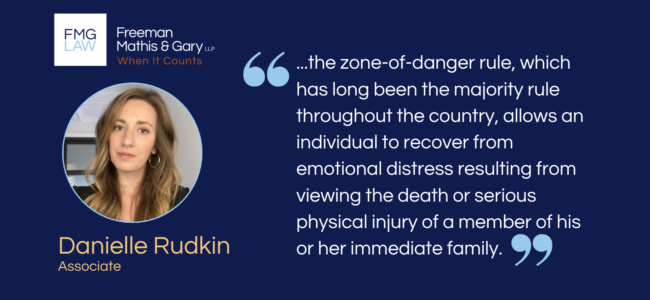BlogLine
Kings County considers possible expansion of the zone of danger when it comes to family pets
10/23/24

An expansion of the “zone of danger” doctrine in New York is presently being considered by the Kings County Supreme Court, and whether one can maintain a cause of action for the negligent infliction of emotional distress resulting from the observed death of a family dog. At base, the issue turns on whether a family pet is included within the legal definition of “immediate family,” as evaluated in Greene v. Esplanade Venture Partnership, 36 N.Y.3d 513 (2021).
Specifically, the zone-of-danger rule, which has long been the majority rule throughout the country, allows an individual to recover from emotional distress resulting from viewing the death or serious physical injury of a member of his or her immediate family. Bovsun v. Sanperi, 61 N.Y.2d 219 (1984). The Bovson decision, and its progeny, “did not establish exhaustive boundaries with respect to the universe of ‘immediate family members,’” Greene, supra at 518, and instead left the issue open to balance the intentionally “narrow avenue to bystander recovery,” Trombetta v. Conkling, 82 N.Y.2d 549, 552 (1993), with the evolving legal understanding and recognition of non-traditional familial relationships. Greene, supra at 524.
Now before the Court, a pedestrian seeks to recover mental, emotional, and psychological damages stemming from a July 4, 2023 incident wherein her family dog was struck and killed by a motor vehicle while out on a walk in Brooklyn, New York. Specifically, the pedestrian was walking her family dog on a leash when the dog was struck and killed by a driver who failed to stop at the stop sign, and while the pedestrian and her dog were legally within the crosswalk. Deblase v. Hill, 83 Misc.3d 1242(A), Slip Op. (Sup. Ct. Kings County July 15, 2024).
Attorneys for the pedestrian moved for Summary Judgment on the issue of liability, and the driver’s counsel cross-moved for dismissal of plaintiff’s complaint pursuant to CPLR 3211(a)(7) for failure to state a claim upon which relief may be granted. In support of the cross-motion, the driver’s counsel argues the portions of the complaint which seek mental, emotional, and psychological damages due to the death of the dog must be dismissed insofar as the zone of danger doctrine is limited to members of one’s immediate family, citing Greene, supra. Instead, the driver contends that pets are personal property, and as such, damages are limited to the fair market value of the dog, and the cost of reasonable veterinary care.
In opposition, the pedestrian advocates for a change in the law, citing to the “evolving notions of the status of companion animals in the law.” Deblase, supra at 3. Upon review of the submissions on this issue, the Court invited submissions of amicus curiae briefs to provide a more thorough analysis of the issue. To date, amicus briefs have been submitted by both sides, and the parties’ motions marked full submitted, with decision reserved for written opinion.
This will be an area to follow, particularly with respect to the potential for increased exposure to insurance companies and, in turn, consumers, should the Court implement an expansion of the law as urged by the pedestrian’s counsel.
Please do not hesitate to contact Danielle M. Rudkin at danielle.rudkin@fmglaw.com or your local FMG relationship partner to learn more.
Share
Save Print
